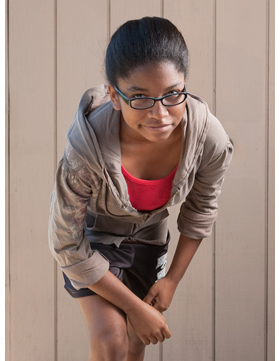
Rebecca Parrish, who suffered from a severe curvature of the spine, had surgery at Rady Children’s. A track runner, she will benefit from the EOS system, a new 3-D, ultra-low-dose X-ray system at Rady Children’s.
Children like Rebecca Parrish with spinal deformities such as scoliosis are benefitting from EOS, new imaging technology at Rady Children’s Hospital-San Diego. EOS makes monitoring their condition safer and helps doctors to develop better treatment plans. For the first time, doctors are able to see a three-dimensional view of the spine in a standing, weight-bearing position.
“Scoliosis creates a very complex deformity of the spine,” said Peter Newton, M.D., an orthopedic surgeon and scoliosis authority at Rady Children’s. “With this technology, we can see the spine in a way we’ve never seen it before. The EOS system allows us to expand our knowledge in the care and treatment of patients.”
Being able to study a 3-D image taken while a child is standing — something that is not possible with a CT-scan — will help doctors determine the ideal orientation of the spine.
“With scoliosis, it’s so important to get the proper position of the head, spine and hips. Our goal is to make the spine as normal shaped as possible,” Dr. Newton said. “The EOS system will help us better monitor progress and the outcomes of our treatments.”
In May, Rady Children’s became the first pediatric hospital in the nation to install the EOS ultra-low-dose imaging system — unique technology that captures a head-to-toe 3-D image of a patient in a standing, weight-bearing position while using a considerably reduced amount of radiation. It’s a state-of-the-art improvement for patients and physicians alike, helping to minimize radiation exposure and provide more comprehensive images for better surgical planning.
“With the EOS system, X-ray exposure is now about eight times less,” said Dr. Newton. “That is a huge advantage for these children.”
Children being treated for scoliosis need numerous sets of X-rays over several years while doctors monitor them to see if the curve is progressing. There is a concern that repeated exposure to radiation could have harmful consequences. Being able to significantly reduce the amount of radiation exposure with the EOS system is especially important for children and adolescents.
Doctors aren’t sure what causes the most common types of scoliosis — a curvature of the spine that develops during the growth spurt just prior to puberty — but it tends to run in families. Neuromuscular conditions, such as cerebral palsy or muscular dystrophy, and birth defects that affect the spine’s development cause other kinds of scoliosis.
Girls and boys develop the disorder at the same rate, but girls are at higher risk for the curve to progress and require treatment. Treatment can range from routine checks during growth to surgery. Sometimes, patients wear a brace.
Rebecca, 14, knows that all too well. Diagnosed with scoliosis in 2004, she underwent spinal fusion surgery last year to correct a significant curve. Scoliosis wasn’t a surprise, however. Her older sister, Marie, also had scoliosis, but to a lesser degree.
Only a small percentage of patients with scoliosis have a curve that progresses to the level that requires surgery. When Rebecca started treatment, her spine had a 37-degree curve, and she was at very high risk of it progressing to the surgical range. Despite an early attempt at bracing, the curve increased to 60 degrees.
“I thought it was going to be troublesome,” Rebecca said about the brace. Faced with surgery, however, she was ready to get it over. Her biggest concern was being sidelined from her favorite sport. Now, she’s eager to start running again with her school track team and defend her undefeated position in the 4 x 100 meter relay.
“I was worried I wouldn’t be able to do track anymore,” said the San Marcos teenager, but Dr. Newton and other Scoliosis Center staff put her at ease. “They’re all really friendly and didn’t make me feel stressed out about it.”
When she goes for her one-year follow-up, Rebecca will step into the EOS, which is about the size of a dressing room, place her hands on a panel and stand still. Two horizontal X-ray beams will scan her body in about 20 seconds and show doctors exactly how her spine has healed since the corrective surgery.
Dr. Newton says the ninth-grader can get back on the track.
“She will be released to all activity without restriction,” he said. “Rebecca has had a spectacular correction and we anticipate she will function normally for all practical purposes.”
The San Diego Union-Tribune Kids’ Newsday, October 2010